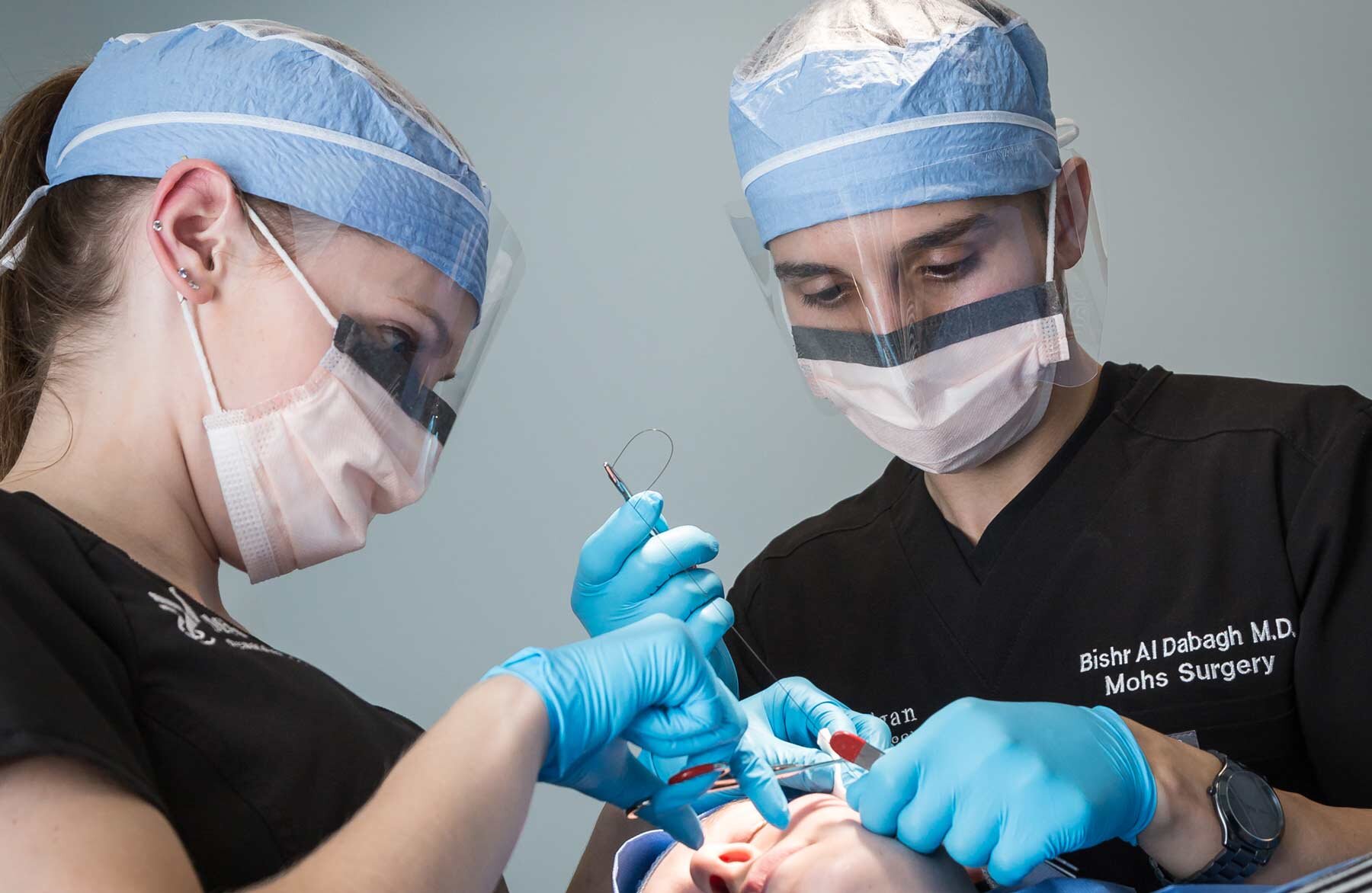
Squamous Cell Carcinoma
What is Squamous Cell Carcinoma?
Excessive sun exposure, sun damage, and other factors can cause mutations in skin cells that accumulate to cause actinic keratosis (pre-cancerous spot) and squamous cell carcinoma. Squamous cell carcinoma is the second most common type of skin cancer. These lesions appear scaly, red, and do not go away on their own. They may also bleed or occasionally become painful. Various subtypes of squamous cell carcinomas exist. Some develop superficially while other subtypes grow rapidly and become invasive.
WHO IS AT RISK
Anyone who has been exposed to the sun is at risk. While that category includes all of us, some are more susceptible than others. Light-skinned individuals with blonde hair and light colored eyes have the highest risk since they have little pigment protection. The lack of melanin leaves their cell’s DNA more vulnerable to sun damage. A tanning history (whether in the tanning bed or outside) and radiation therapy also increases your risk of skin cancer.
Skin damage is cumulative, adding up over the years. Imagine an empty tank under a leaky faucet that slowly releases water droplets. In the beginning, the drops are barely noticeable, but as the years pass by, the tank starts to fill up. At some point, the tank will overflow; enough skin damage has accumulated in the skin’s DNA, leading to a skin cancer. It is never too late to start using sunscreen and protecting yourself from the adverse effects of ultraviolet radiation.
Immunocompromised individuals (i.e. organ transplant recipients, undergoing cancer treatment or other immunosuppressive medications) are also more susceptible to squamous cell carcinoma. It is highly recommended that these patients visit their dermatologist for an annual skin screening.
HOW DO I PROTECT MYSELF?
While you may enjoy basking in the sun on a breezy summer day, make sure to take the proper precautions. The main factor in the development of squamous cell carcinoma is ultraviolet (UV) exposure from sunlight. Therefore, the first layer of protection is avoidance. Peak sunlight hours occur from 10 AM to 2 PM, during which UV radiation is the strongest. You can enjoy nice weather, but try to venture outside before 10 AM or after 2 PM. Seek the shade when possible.
Your second line of defense is clothing, including a wide-brimmed hat, long sleeves, and pants. Some manufacturers have now started to identify clothing with a UPF (Ultraviolet Protection Factor) rating, similar to sunscreen’s SPF (sun protection factor). If possible, choose clothing with a UPF of 50 or above.
Sunscreen is also very important. Apply a cream with an SPF 30 or higher before heading outside. If you stay outside for more than 2 hours, make sure you re-apply every 2 hours. Now enjoy the sunshine!
I'M WORRIED I MAY HAVE SKIN CANCER...
Take a deep breath. Chances are, you probably know a relative, friend, or neighbor who have had a skin cancer. You may even know someone who passed away from cancer. It is important to recognize that not all skin cancers are the same. Some are less aggressive when caught early, like squamous cell carcinoma. Others, like melanoma or Merkle cell carcinoma, may be more dangerous.
If you are worried about a lesion, please make an appointment to see one of our dermatology specialists. There is no substitute for a trained provider giving you the reassurance or testing you need to arrive at the diagnosis. While it is tempting to ask “Dr. Google” and self diagnose it is much safer to schedule a quick visit for our providers to give you peace of mind.
I WAS DIAGNOSED WITH SQUAMOUS CELL CARCINOMA ON MY SKIN, NOW WHAT?
If your biopsy confirms a squamous cell carcinoma, your provider will discuss the treatment options with you. Depending on the size, location, and aggressiveness (there are many subtypes of squamous cell carcinoma), your provider will work with you as a team to find the best treatment option. It may be a topical cream, an injection, a surgical procedure, or radiation treatment. The good news is squamous cell carcinomas are highly curable, especially when caught early. The earlier the squamous cell carcinoma is treated, the more likely you can avoid larger surgical scars and local spread.

